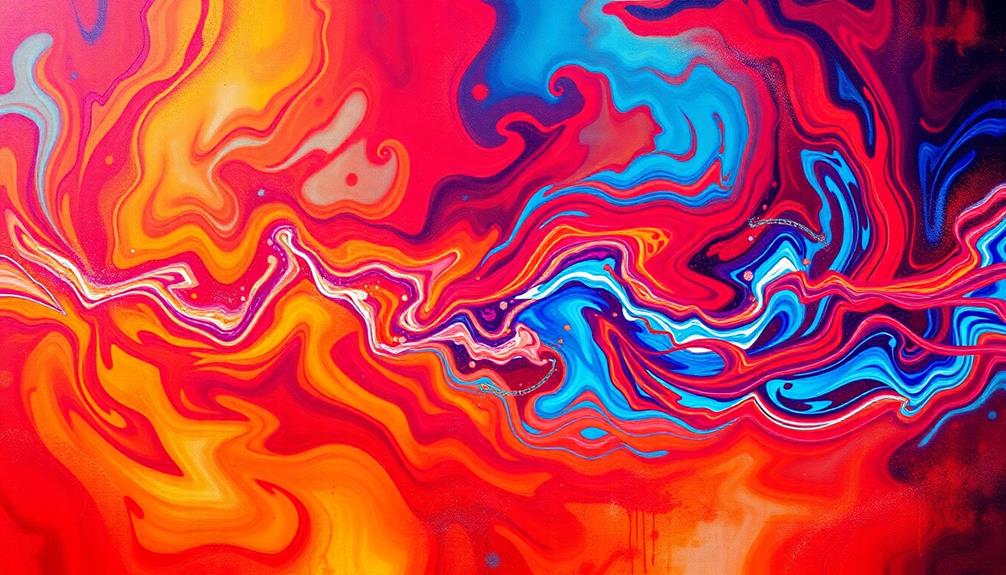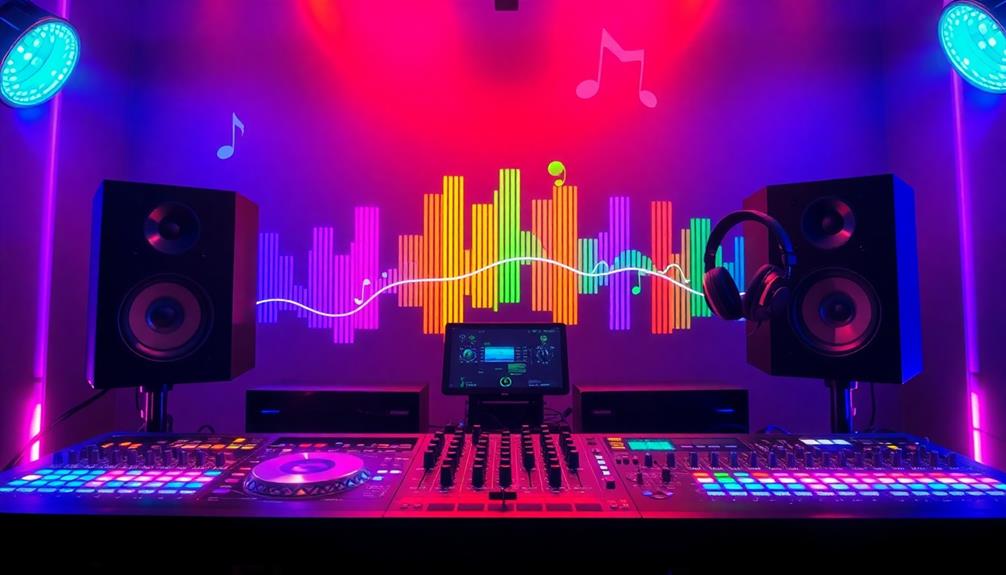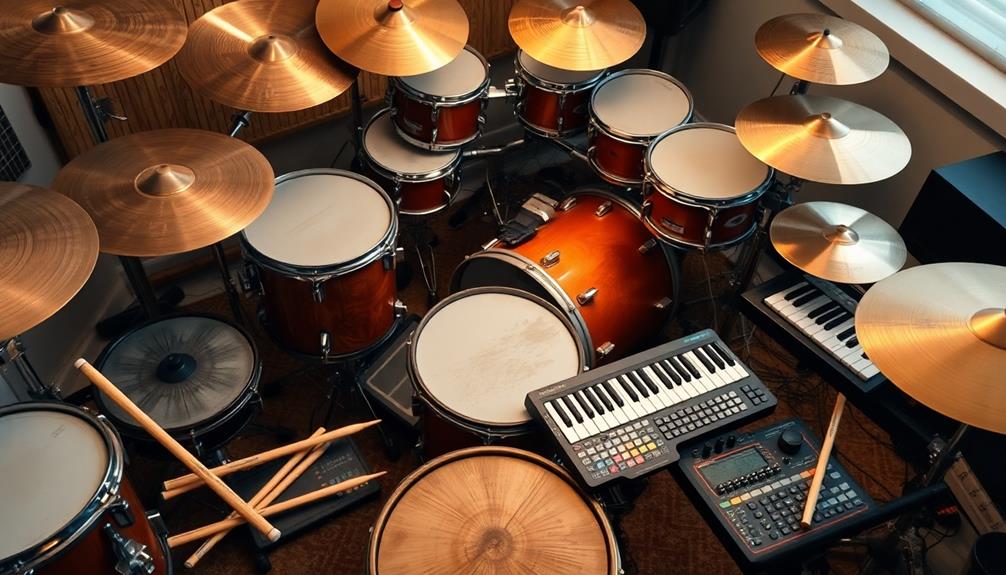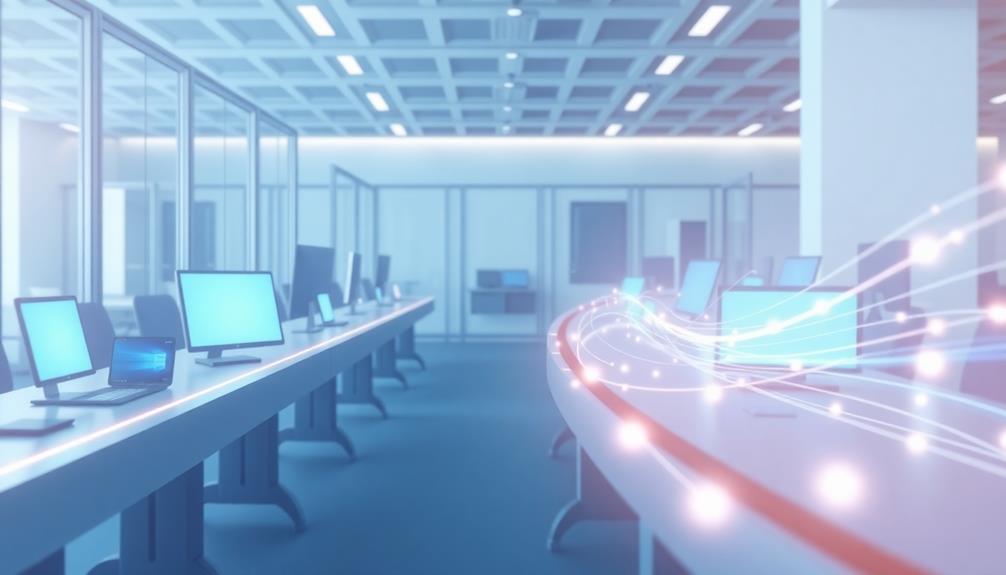To create lush synth pads, start by tweaking your ADSR envelope for a slow attack and long release. This gives your sound a warm, inviting fade-in. Layer multiple oscillators with slight detuning to enrich the texture, and use LFOs to modulate parameters like filter cutoff for added movement. Don't forget effects like reverb and delay to enhance depth and create an immersive atmosphere. Experiment with different waveforms and modulation techniques to keep your pads dynamic and fresh. There's much more to explore to elevate your sound design, so keep pushing your creativity for inspiring atmospheres.
Key Takeaways
- Utilize a slow attack and long release in the ADSR envelope for immersive fade-in and atmospheric sound quality.
- Layer multiple oscillators with slight detuning to enhance richness and create engaging phasing effects in your synth pads.
- Employ LFOs to modulate filter cutoff and amplitude, introducing dynamic movement and evolving textures in your pads.
- Incorporate generous reverb and delay effects to add depth and create a lush, immersive soundscape within your tracks.
- Experiment with different waveforms and modulation techniques to develop unique tonal qualities and maintain interest in your synth pads.
Understanding Synth Pads

When you immerse yourself in the world of synth pads, you'll discover they're essential for creating lush soundscapes in your music. These sustained chords or drones provide a rich, polyphonic backdrop that enhances the textural and atmospheric quality of your tracks.
To truly understand synth pads, pay attention to their key characteristics, particularly the attack time and release time within the ADSR envelope. A slow attack time allows the sound to gently fade in, creating a smooth and inviting entrance, while a long release time guarantees the sound lingers beautifully, fading out gradually.
You'll typically use simple chord structures, such as triads, to maintain clarity and avoid overwhelming complexity. Layering multiple oscillators and slightly detuning them can add depth, emulating the lushness found in orchestral settings.
To keep your synth pads dynamic and engaging, incorporate modulation techniques like LFOs. This movement adds expressiveness and prevents the pads from sounding static, offering a fascinating experience for your listeners.
Essential Synthesis Techniques

To craft lush synth pads, start by adjusting your ADSR envelope settings for a slow attack and long release.
Next, experiment with oscillator detuning techniques to create a rich, textured sound.
These essential synthesis techniques lay the foundation for your expansive soundscapes.
ADSR Envelope Settings
Understanding ADSR envelope settings is vital for crafting lush synth pads that evoke depth and atmosphere. The ADSR envelope consists of four stages: Attack, Decay, Sustain, and Release.
For your pad sound, start with a slow attack time. This creates a smooth fade-in, allowing the sound to swell gently and immersively.
Next, consider the sustain level; setting it to a medium or high value helps maintain a steady sound while you hold the note, giving your pad the body it needs.
Additionally, a longer release time is important, as it allows notes to fade gradually after releasing the key, enhancing that atmospheric quality.
Don't forget to synchronize filter envelopes with amplitude envelopes. This synchronization preserves the harmonic structure and texture of your pad throughout its duration.
Oscillator Detuning Techniques
How can you instantly elevate your synth pads? One effective way is through detuning oscillators. By slightly detuning them by a few cents, you create a phasing effect that adds richness and depth, simulating multiple instruments playing together.
When you use multiple oscillators in a unison configuration, this technique duplicates the sound. The slight detuning results in a wider and fuller texture for your pads.
To create an engaging atmosphere, layer additional detuned oscillators. Each one contributes unique tonal characteristics, enhancing the overall lushness. Experimenting with different waveforms across these oscillators can lead to varied harmonic content, giving you more complex and interesting pad sounds.
Don't forget the power of modulation! Adjusting the subtleties of detuning dynamically with LFOs can create evolving textures, preventing your pads from sounding static.
This way, you can maintain a sense of movement and depth in your music. So go ahead, start detuning oscillators and watch how they transform your synth pads into rich, immersive soundscapes that really captivate your listeners.
Designing Lush Pad Sounds

When you're designing lush pad sounds, oscillator layering is key to creating a rich texture.
By slightly detuning multiple oscillators, you can achieve an intriguing phasing effect.
Don't forget to incorporate modulation for movement—this will keep your pads dynamic and engaging.
Oscillator Layering Techniques
Lushness in synth pads stems from the artful layering of oscillators, which can transform simple tones into enchanting soundscapes. By slightly detuning a second oscillator from the first, you create a rich phasing effect that enhances the overall lush sound. Utilizing the unison feature also allows you to duplicate oscillators with slight detuning, resulting in a wider, fuller sonic texture.
Experiment with different waveforms for each oscillator—combining sawtooth and sine waves can yield unique tonal qualities. Additionally, playing a triad can greatly increase harmonic complexity; for example, three notes played together can result in six voices, enriching your pad sound. Adjusting the stereo width of the oscillators further enhances the spatial quality, making your pad feel more expansive in the mix.
Here's a table summarizing key oscillator layering techniques:
| Technique | Description | Effect |
|---|---|---|
| Slight Detuning | Layer oscillators slightly apart | Rich phasing effect |
| Unison Duplicates | Duplicate oscillators with slight detuning | Wider, fuller sound |
| Mixed Waveforms | Combine different waveforms | Unique tonal qualities |
Modulation for Movement
Building on the oscillator layering techniques, modulation plays a significant role in creating movement within your synth pads. By assigning LFOs to parameters like filter cutoff, oscillator pitch, or amplitude, you can inject dynamic movement into your sounds, preventing them from feeling static.
Experiment with multiple LFOs using different waveforms and rates to achieve complex sound evolution, enhancing the richness of your pad texture.
Additionally, consider implementing modulation through envelopes. For instance, using pitch or filter modulation based on note velocity adds expressiveness and variation, making your pads feel more alive.
Don't overlook the power of chorus effects; they can thicken your pad sounds and create a lush spatial quality. Periodically modulating the chorus parameters adds depth and further enriches the listening experience.
Utilizing LFOs for Movement
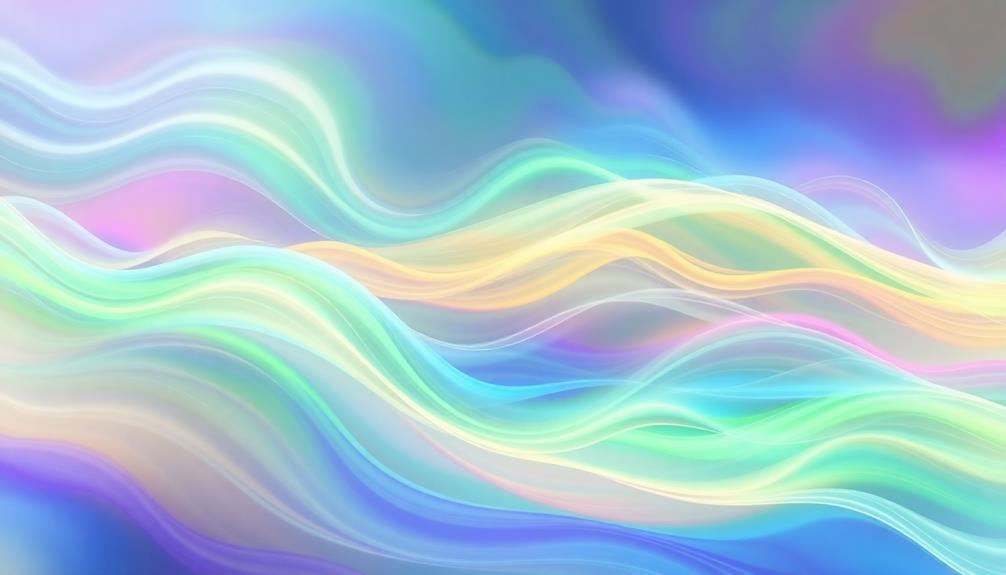
To inject movement into your synth pads, tapping into the power of LFOs (Low-Frequency Oscillators) is essential. LFOs modulate synth parameters at slower-than-audible speeds, allowing for dynamic changes that prevent your pads from sounding static. By assigning LFOs to parameters like filter cutoff, amplitude, or pitch, you can create evolving textures that enrich your sound.
Experimenting with different types of LFO waveforms is key. Each waveform offers unique modulation effects that can dramatically alter how your pads make it sound. Here's a quick overview:
| LFO Waveform | Effect on Pad Sound |
|---|---|
| Sine | Smooth, gradual modulation |
| Sawtooth | Sharp, rising modulation |
| Square | Abrupt, rhythmic changes |
| Triangle | Balanced, smooth shifts |
| Random | Unpredictable, evolving textures |
Using multiple LFOs allows you to control different parameters simultaneously, leading to complex layers and sound evolution. Adjusting LFO rates and depths can create contrasting effects: slow modulation fosters smoothness, while fast modulation brings rhythmic energy. Embrace LFOs to transform your synth pads into atmospheric masterpieces.
Enhancing Pads With Effects

To truly enhance your synth pads, you'll want to focus on key effects like reverb, delay, and modulation.
Reverb can add depth, while delay offers intriguing textures that complement your sounds.
Modulation techniques can further thicken your pads, making them feel richer and more immersive in your mix.
Reverb for Depth
Reverb can transform your synth pads, giving them a lush, immersive quality that makes them feel expansive and alive. By creating a sense of depth, reverb makes your sounds feel as though they occupy a larger physical space.
You'll want to experiment with decay times; longer settings yield a grand, vibrant atmosphere, while shorter ones provide a more intimate touch.
Adjusting parameters like pre-delay and wet/dry mix is essential, too. A little bit of tweaking here guarantees the reverb complements your pads without overwhelming them.
Remember that sounds are typically more engaging when there's movement, so consider modulating your reverb settings, like subtly altering decay or mix levels over time.
Layering different types of reverb—such as hall and plate—can add complexity and richness. This technique creates a more intricate and textured sonic landscape, enhancing the overall sound.
With these adjustments, your synth pads won't only sound lush but also dynamic and enthralling, drawing listeners into your atmospheric tracks.
Experiment with these techniques, and you'll find the perfect reverb settings to elevate your synth pads.
Delay for Texture
Delay can be a powerful ally in crafting lush synth pads that resonate with texture and depth. By utilizing delay effects, you can create a sense of space and dimension within your sounds. Adjust the feedback settings carefully; you want the repeats to enhance your mix without cluttering it.
For a doubling effect, experiment with short delay times, which can give your pad a fuller sound. On the other hand, longer delay times can add rhythmic patterns that enrich the overall texture. You might also consider modulating the delay time or feedback level over time, introducing dynamic movement that keeps the listener intrigued.
Combining delay with reverb can elevate the atmospheric quality of your pads even further. This combination allows a wash of sound that fills the sonic space effectively, creating an immersive experience.
Additionally, using filters on your delay sends can help shape the tonal character of the repeated notes. This guarantees they blend smoothly with the original pad sound, maintaining clarity while enhancing the lushness.
With these techniques, your synth pads will gain the depth and texture essential for engaging atmospheric tracks.
Modulation Techniques Overview
Building on the textural foundation established with delay, modulation techniques can elevate your synth pads to new heights. By assigning low-frequency oscillators (LFOs) to parameters like filter cutoff or amplitude, you can create dynamic changes that lead to evolving textures, enhancing the listener's experience.
Experimenting with multiple LFOs featuring varying rates and waveforms will add complexity and interest, making your pad sound richer.
Incorporating modulation effects such as chorus and flanger thickens your sounds while providing a spatial quality, allowing your pads to feel expansive and immersive within the mix. To keep your sound evolving, regularly adjust parameters during performance or composition; this prevents your pads from sounding static or monotonous.
Additionally, implementing time-based effects like reverb and delay can greatly enhance your pads' ambiance. However, it's essential to balance these effects to maintain clarity and avoid muddiness in your overall mix.
Layering and Sound Textures

When you layer multiple oscillators in your synth pad, you can dramatically enhance its richness and depth. By slightly detuning one oscillator, you create a phasing effect that adds a unique sonic texture. This simple technique can make your pad feel more alive and engaging.
Using unison voices to duplicate oscillators with slight detuning can widen the sound, emulating the lushness of orchestral settings where multiple instruments harmonize beautifully.
Incorporating varying waveforms in your layers further enriches the sound. Each waveform contributes its unique harmonic characteristics, resulting in a more complex and intriguing pad. Don't hesitate to experiment with different combinations to find what resonates with your track.
To elevate your layered sounds, employ effects like reverb and delay. These effects enhance the spatial quality, creating an immersive atmosphere that envelops the listener.
Practical Sound Design Tips
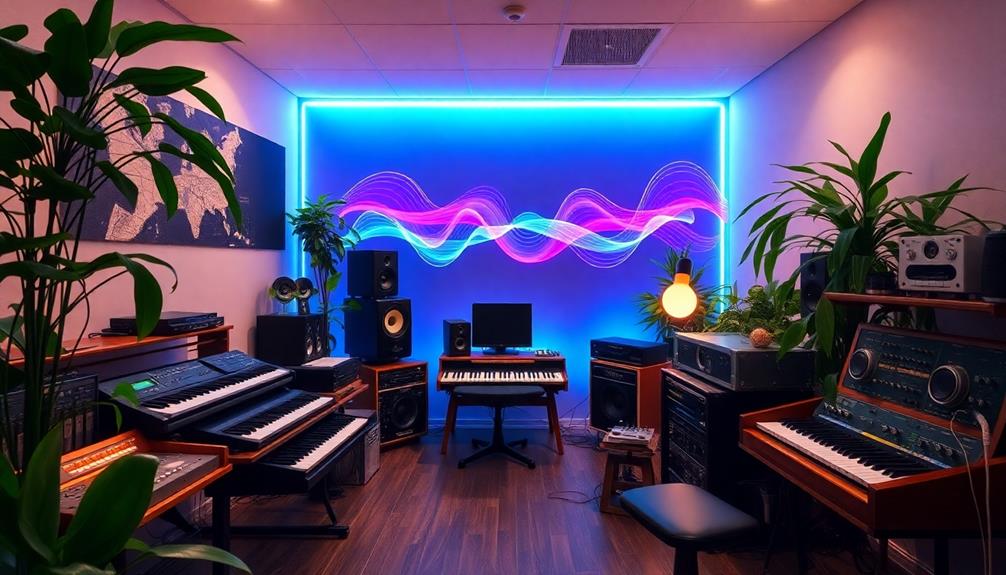
To create truly lush synth pads, practical sound design tips can help you refine your approach. Start with simple waveforms and tweak your ADSR envelope settings to feature a slow attack and long release. This will give your pads that smooth fade-in and fade-out characteristic.
Layer multiple oscillators and slightly detune them to achieve a rich phasing effect, adding depth to your sound. Incorporate LFO modulation on parameters like filter cutoff and pitch. This introduces subtle movement, ensuring your pads don't sound static.
Using effects like reverb and delay generously can create a sense of space and ambiance. Adjust the decay and feedback settings to enhance the lushness of your pad sound.
Don't hesitate to experiment with sound processing techniques. Auto filters and modulation effects like chorus can further enrich your synth pads, adding complexity and texture.
Modulation for Dynamic Pads
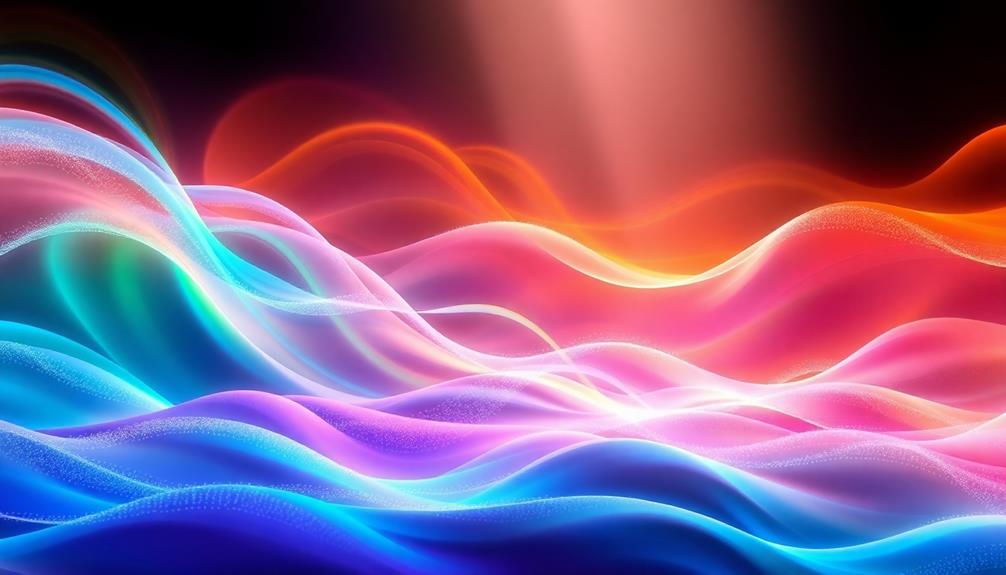
Modulation plays an essential role in creating dynamic pads that evolve over time, keeping your sound engaging and expressive. By using Low-Frequency Oscillators (LFOs) to modulate parameters like filter cutoff or amplitude, you can introduce dynamic changes that prevent your pads from sounding static. This enhances their expressiveness considerably.
To create rich textures, consider these key strategies:
- Assign multiple LFOs to different parameters, allowing for complex sound evolution.
- Contrast slow and fast modulation rates for added interest.
- Use modulation through envelopes to add movement, influenced by velocity and note pitch.
Don't forget to incorporate effects like chorus and reverb. They thicken your sound and enhance spatial qualities, contributing to that lush, atmospheric feel you're after.
Regularly adjusting LFO rates and parameters during your sound design sessions keeps your pads fresh and interesting. This evolving approach guarantees your pads maintain a fascinating presence throughout your tracks.
Application in Music Genres
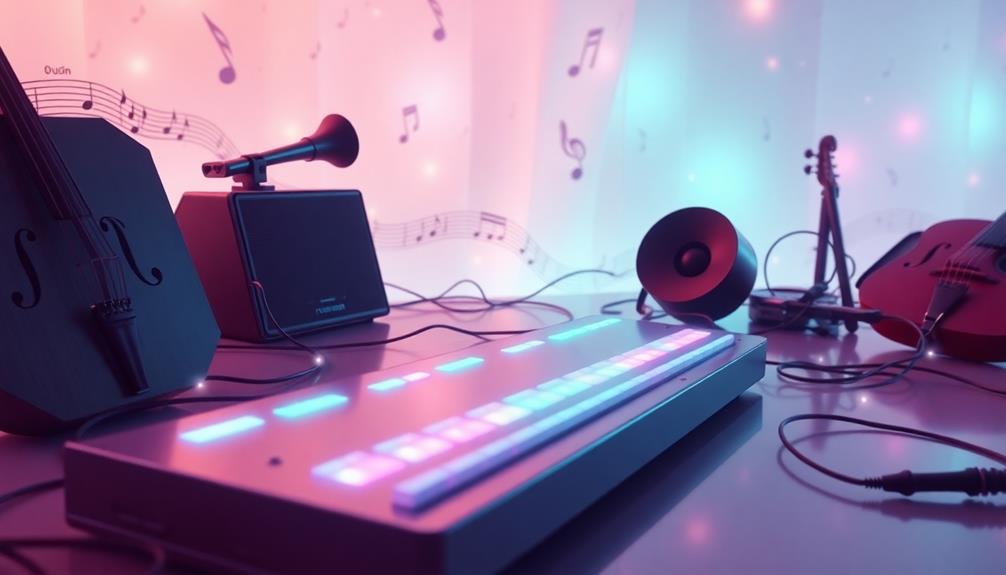
Lush synth pads find their way into a variety of music genres, enriching the overall sound and enhancing emotional resonance. In electronic music, especially ambient, trance, and downtempo, these pads provide a rich atmospheric foundation that pulls listeners into a deeper experience.
When you venture into cinematic music, pads become essential, creating expansive soundscapes that evoke emotion and tension, perfect for film scores and video game soundtracks.
Pop and rock genres often incorporate ambient pads to add depth and texture, supporting lead vocals and instrumental solos. By doing this, you create a fuller sonic palette that captivates your audience.
In jazz and fusion styles, lush pads offer unique harmonic backgrounds, allowing for improvisation and intricate melodic lines to thrive.
Their versatility makes lush synth pads a staple in modern music production. Whether you're crafting an ethereal soundscape or layering textures to enhance a song's emotional impact, pads fill sonic space and invite listeners into immersive environments.
Embrace these tools in your music, and you'll elevate your tracks to new heights, making your sound truly unforgettable.
Continuous Learning in Sound Design
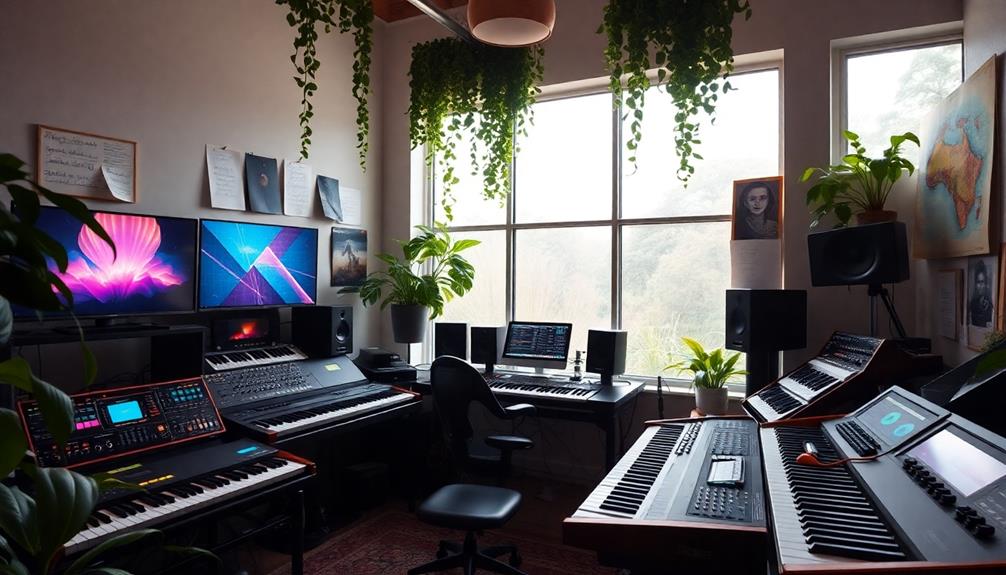
Mastering sound design, especially when it comes to creating rich synth pads, requires a commitment to continuous learning. The world of sound design is always evolving, with new techniques and tools emerging regularly. To stay ahead, you need to actively engage in learning and experimentation.
Consider these approaches to enhance your skills:
- Explore online tutorials: They can provide fresh insights and innovative methods for synthesizing lush pads.
- Join community forums: Engaging with other musicians allows you to share ideas and receive valuable feedback.
- Practice regularly: Experimenting with different synthesis methods helps you develop unique textures and sounds.
Additionally, keeping up with software updates, plugins, and sound libraries can considerably expand your creative toolkit.
Feedback from peers and experienced sound designers is essential; it helps refine your techniques and introduces new perspectives.
By embracing continuous learning, you not only improve your ability to craft atmospheric tracks but also foster personal growth as an artist.
Remember, the more you learn and experiment, the more unique and enchanting your synth pads will become.
Frequently Asked Questions
How to Make a Lush Pad?
To make a lush pad, start with a slow attack and long release. Layer oscillators, add reverb and delay for depth, and modulate with LFOs to create movement. Experiment with sounds for a rich texture.
How to Create an Ambient Synth?
To create an ambient synth, you'll want to embrace gentle waves, allowing soft sounds to caress your ears. Layer, modulate, and sprinkle effects for a lush, ethereal experience that transports you to serene soundscapes.
What Is a Lush Pad?
A lush pad's a rich, expansive sound that resembles orchestral harmonies. You achieve this by layering oscillators, detuning them slightly, adding unison voices, and using effects like reverb and delay for depth and atmosphere.
What Are Pads in Synth?
Imagine spinning a vinyl record—pads in synth create a rich, textured backdrop, blending sustained chords or drones that evolve harmonically. They're essential for adding depth and atmosphere, enhancing your music's emotional resonance.
Conclusion
In crafting lush synth pads, you're not just layering sounds; you're painting emotions in the air. By exploring synthesis techniques and effects, and embracing modulation, you breathe life into your tracks. Remember, every pad you design can transform a moment, drawing listeners into an enchanting atmosphere. So, keep experimenting and evolving—after all, the journey of sound design never truly ends. Let your creativity flow and watch as your music becomes a vibrant tapestry of sound.


